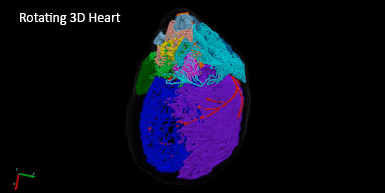
SPARC1 projects are mapping the innervation of organs and tissues, and identifying new targets for future neuromodulation therapies—treatments that directly alter nerve function
Cardiac function is tightly controlled to ensure the heart never skips a beat. At the center of this ability is the intracardiac nervous system (ICN), the heart’s own internal nervous system that helps regulate functions like rhythm and blood flow. The neurons that comprise the ICN are found in clusters within the heart, but their exact positions and functions have never been comprehensively mapped. The NIH Common Fund’s Stimulating Peripheral Activity to Relieve Conditions (SPARC) program supports efforts to map nerve structures like the ICN so they can be targeted more specifically by neuromodulation therapies.
Now a team at SPARC awardee institution Thomas Jefferson University, led by Dr. James S. Schwaber, has illuminated the form and function of the rat ICN at single cell resolution within the whole heart. They used a technique called knife-edge scanning microscopy (KESM) along with single cell gene activity data to create a comprehensive map of the heart. As the name suggests, KESM collects images from deep within tissues by scanning along a knife-edge as it sequentially removes one layer of tissue at a time. The 3D structure is then rebuilt from the scanned images. In a parallel process, individual neurons are laser-cut out of the tissue, profiled for active genes, and then oriented to their correct position within the 3D map of the heart. The resulting data set reveals a high level of complexity and diversity of ICN neuron anatomy and function that will stimulate additional research, including identification of potential therapeutic targets, both surgical and neuromodulatory. The reproducible techniques used in this study can be applied to other organs and systems, opening up a new pipeline for high-resolution mapping of neurons within organ systems.
Read more about this work in these news reports: Science News, Engadget, STAT , BBC Science Focus , Interesting Engineering, Cardiovascular Business, News Medical, Report Door , Cosmos Magazine, Neuro Central, and Slash Gear.
The raw data supporting the study’s conclusions are available on the SPARC Portal.
>Reference
- A Comprehensive Integrated Anatomical and Molecular Atlas of Rat Intrinsic Cardiac Nervous System. Achanta S, Gorky J, Leung C, Moss A, Robbins S, Eisenman L, Chen J, Tappan S, Heal M, Farahani N, Huffman T, England S, Cheng ZJ, Vadigepalli R, Schwaber JS iScience. 2020 May 23.


